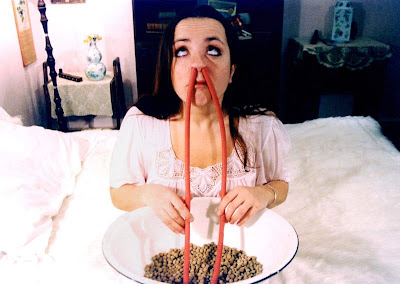Conspirators of Pleasure (Jan Svankmajer, 1996): Czech Republic
Reviewed by Kevin Tran . Viewed on DVD.
 I find paranoia to be one of the most interesting themes explored in cinema. Paranoia is a feeling that we all share and understand, and so when we watch a film where our protagonist is caught in a situation where he feels watched, outnumbered or criticized, there is often a very strong connection between subject and audience. Films such as Roman Polanski’s Rosemary’s Baby and Alfred Hitchcock’s North by Northwest are prime examples, just to name a few classics. However, Jan Svankmajer’s Conspirators of Pleasure takes the theme to new creative extremes.
I find paranoia to be one of the most interesting themes explored in cinema. Paranoia is a feeling that we all share and understand, and so when we watch a film where our protagonist is caught in a situation where he feels watched, outnumbered or criticized, there is often a very strong connection between subject and audience. Films such as Roman Polanski’s Rosemary’s Baby and Alfred Hitchcock’s North by Northwest are prime examples, just to name a few classics. However, Jan Svankmajer’s Conspirators of Pleasure takes the theme to new creative extremes.
There are tools that filmmakers can utilize to illustrate this complex feeling of paranoia. As if the walls were closing in on us, trying to trap us. Svankmajer not only utilizes his creativity and skills in stop motion animation, but also he over utilizes traditional film language tools such as fast editing, flattening out the image using long lens photography, and uncomfortable close ups. Svankmajer is very bold and daring to use these tools as much as he does in Conspirators. Watching the film, or perhaps any Svankmajer film, is as uncomfortable as watching an adult film with your parents. It is not what the typical moviegoers expect and that is what makes his films so fascinating to look at and study.
If we observe the opening scene of the film, we find that it is a good example of Svankmajer’s style and how he creates tension and paranoia. Mr. Pivonka, our protagonist, walks into a store wanting to buy an adult magazine. He attempts to look at it inconspicuously and tries buying it nonchalantly from the store owner, Mr. Kula. His eyes dart back and forth between the magazine and the store owner. Svankmajer cuts quickly between tight close ups of each character’s face looking at one another. He is especially focused on their eyes. With these close ups, we really see into the world of Pivonka. We see the sweat beaming from his forehead. We see the he sees that the store owner knows (from the smug smile on Kula’s face) what Pivonka really wants. And we see that Pivonka is utterly embarrassed and ashamed. Although the scene all happens quickly, the suspense is rather immense. It is escalated to the point when Pivonka quickly buys the magazine without getting his change back from Kula.
The narrative of Conspirators is as unusual as it’s plot. There is a main character, Mr. Pivonka, but we also follow many other character’s who essentially share his same suspicion that other people are trying to uncover their own individual secret. A secret that gives them pleasure, which society might find unusual or distasteful. The film is ultimately about how individuals are isolated in society. That we don’t trust our neighbors. That we should not seek pleasure. Since Svankmajer made the majority of his animations during communism, where his art was censored and he was unable to make the films he wanted, we could see how this theme is so important for him to explore.
It is interesting to look at what each character is hiding from one another. We learn that Mr. Pivonka uses the adult magazine to create a paper mache chicken costume. That his mail delivery woman enjoys making little condensed balls of bread. That Mr. Kula, in love with the female local television news anchor, Mrs. Beltinska, makes love to her via a machine he welds together from different electrical household devices. She finds solace and comfort in petting two enormous fishes that she keeps in a bucket beneath her bed. And then Mr. Beltinska, the news anchor’s husband who goes lengthy distances to create the perfect apparatus for pleasure making. All of these quirky “hobbies” or fetishes are strange and bizarre, but are all totally irrelevant in one’s private home. It is when these characters are in the public sphere is when they become paranoid, looking over their shoulders and checking the locks on their doors, utterly afraid of being discovered. Svankmajer could be saying that perhaps one can only be happy alone and when no one is looking.
Svankmajer explores the human desire for pleasure with these characters. The need express love in a society that is so isolated and cold. It could be said that we all have our own unique way of getting pleasure. It is a human right. It is interesting then, why society must deny us the pleasure that we all need and want. Svankmajer’s world may be a little extreme, but the exaggeration is what makes the film so entertaining. The absurd is humorous. But Svankmajer’s satire also directs our eyes at an aspect of society that he sees as an important thing for people to recognize. Svankmajer’s message is not quite clear whether he sees this as a negative aspect of society or simply illuminating it, however, by the way society is represented in the film, we can assume it is both.
1 Comment
Jump to comment form | comments rss [?] | trackback uri [?]